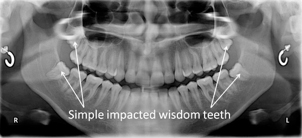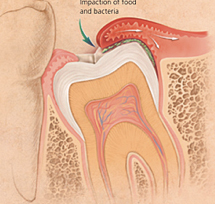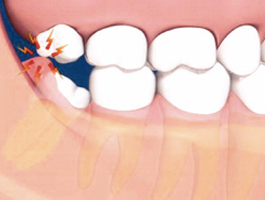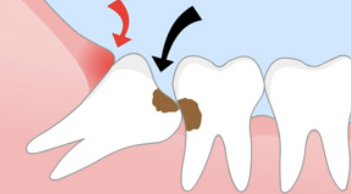WISDOM TEETH
The wisdom teeth (or third molars) are usually the last teeth to arrive between the ages of 18 – 24 years. As the wisdom teeth come through they may cause problems. If there is not enough room to accommodate wisdom teeth they do not erupt into the mouth normally. Impaction occurs when there is prevention of complete eruption. This may be due to lack of space, other teeth being in the way or development in an abnormal position.
For most people, impacted wisdom teeth will cause no problems. However some people can suffer problems such as inflammation of the surrounding gum (pericoronitis), a higher risk of tooth decay (caries), gum disease (periodontal disease) cyst formation around the wisdom tooth if it does not come into the mouth properly, and possibly experience problems with teeth or jaws in later life. It is usually the lower wisdom teeth which cause problems. It is rare for problems to arise from upper wisdom teeth.

An OPG X-rays can show wisdom teeth impaction.
Indications for surgical removal of impacted third molars include:
- Repeated pericoronitis of the gum surrounding the tooth.
- Unrestorable caries (decay).
- Chronic infection at the root of the tooth that is not otherwise treatable.
- Internal/external resorption of the tooth or adjacent teeth.
- Where a cyst has developed around the wisdom tooth.
- Fracture of the tooth or jaw bone associated with trauma.
- Removal prior to orthognathic surgery.
- When a tooth is involved in or within the field of tumour resection.

Food getting trapped under gum flap which causes inflammation of gum flap swelling and pain

Sometimes the upper wisdom tooth traumatises the swollen and inflamed gum flap causing exacerbation of pain and swelling.

Food gets trapped between teeth (black arrow).This may cause decay in both teeth(brown),which may require removal of both teeth.
Wisdom teeth may be removed under local anaesthetic, local anaesthetic and intravenous sedation or general anaesthetic. In this practice almost all wisdom teeth are removed under general anaesthetic. There is great variation in the difficulty of removing wisdom teeth. There is also great variation in the pain and discomfort suffered by individuals. The average recovery time is between 5-7 days.
Surgery usually involves making a cut in the gum over the wisdom tooth and removing some bone surrounding the crown of the tooth. It may be necessary to divide the tooth to remove it. Once the wisdom tooth has been removed the gum is stitched back into place.These stitches are dissolvable and take around two weeks to disappear.
If there is decay in an adjacent tooth this may be a problem and you may need to return to your dentist to sort the decay.When the adjacent tooth has a large filling or crown it is possible that this may be dislodged during surgery.
Pain and swelling of varying degree is normal after wisdom tooth extraction. The pain may start 2–3 hours after the extraction, as the effect of local anaesthetic wears off, however the pain can usually be alleviated with simple analgesia (Paracetamol). Swelling will be the most prominent on the day after the procedure .The jaw may be stiff with a reduced mouth opening capability and a soft diet is advisable for a few days. Some bruising of the face and upper neck may occasionally occur.
It is important to keep the extraction sites as clean as possible for the first few weeks after surgery; this is achieved by gently rinsing the area a few times a day.
After wisdom tooth extraction, the tooth socket may ooze blood for a few hours. Compression on the extraction site by biting onto a gauze swab applied to the socket for 15–20 minutes is usually enough to stop normal post-extraction bleeding.
Dry socket (alveolar osteitis) occurs in about 1 in 20 people after wisdom tooth removal. It occurs when a blood clot fails to develop in the tooth socket, or if the blood clot becomes dislodged or disappears. This usually happens three to five days after surgery.The empty socket causes an severe throbbing pain in your gum or jaw. The prescribed pain killers may not control the pain. There may be an unpleasant smell or taste from the empty tooth socket.Factors that increase the risk of developing dry socket are: female sex,smoking,the contraceptive pill,and a difficult extraction.If you develop such symptoms you will need to return to the clinic where the problem can be rectified. A sedative dressing is usually placed in the socket-this dressing mimics the clot and allows the socket to heal.You may require an antibiotic if there is an unpleasant smell or taste present.
Two nerves lie very close to the roots of the lower wisdom teeth. One of these nerves (Inferior alveolar) supplies feeling to your lower lip, chin and lower teeth. The other nerve (Lingual) supplies feeling to your tongue and helps with taste. Sometimes these nerves may be bruised when a wisdom tooth is taken out. This may cause tingling or numbness in your lip, chin or tongue, and more rarely altered taste. About one in ten people will have some temporary tingling or numbness that can last several weeks. Persistent or permanent numbness occurs in less than one in a hundred people. These risks may be higher if your tooth is in a difficult position. You will be told if you are considered to be at an increased risk.
The operation is usually done under a general anaesthetic, you will be asked to follow fasting instructions. This means not eating or drinking, for at least six hours beforehand.You will need to rest for 24 hours until the effects of the general anaesthetic have passed.You will need to arrange for someone to drive you home after the operation. You should try to have a friend or relative stay with you for the first 24 hours. It may be necessary to take a week off work, and avoid strenuous exercise after having a wisdom tooth removed.
